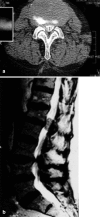Spinal tumors in coexisting degenerative spine disease--a differential diagnostic problem
- PMID: 15221575
- PMCID: PMC3476655
- DOI: 10.1007/s00586-004-0678-4
Spinal tumors in coexisting degenerative spine disease--a differential diagnostic problem
Abstract
The clinical presentation of spinal tumors is known to vary, in many instances causing a delay in diagnosis and treatment, especially with benign tumors. Neck or back pain and sciatica, with or without neurological deficits, are mostly caused by degenerative spine and disc disease. Spinal tumors are rare, and the possibility of concurrent signs of degenerative changes in the spine is high. We report a series of ten patients who were unsuccessfully treated for degenerative spine disease. They were subsequently referred for operative treatment to our department, where an initial diagnosis of a tumor was made. Two patients had already been operated on for disc herniations, but without long-lasting effects. In eight patients the diagnosis of a tumor was made preoperatively. In two cases the tumor was found intraoperatively. All patients showed radiological signs of coexisting degenerative spine disease, making diagnosis difficult. MRI was the most helpful tool for diagnosing the tumors. A frequent symptom was back pain in the recumbent position. Other typical settings that should raise suspicion are persistent pain after disc surgery and neurological signs inconsistent with the level of noted degenerative disease. Tumor extirpation was successful in treating the main complaints in all but one patient. There was an incidence of 0.5% of patients in which a spinal tumor was responsible for symptoms thought to be of degenerative origin. However, this corresponds to 28.6% of all spine-tumor patients in this series. MRI should be widely used to exclude a tumor above the level of degenerative pathology.
Figures


Similar articles
-
Back pain in patients with degenerative spine disease and intradural spinal tumor: what to treat? when to treat?Eur Spine J. 2014 Apr;23(4):821-9. doi: 10.1007/s00586-013-3137-2. Epub 2013 Dec 31. Eur Spine J. 2014. PMID: 24378627 Free PMC article.
-
Imaging of spine neoplasm.Radiol Clin North Am. 2012 Jul;50(4):749-76. doi: 10.1016/j.rcl.2012.04.002. Radiol Clin North Am. 2012. PMID: 22643394 Review.
-
Juvenile degenerative disc disease: a report of 76 cases identified by magnetic resonance imaging.Spine J. 2007 May-Jun;7(3):332-7. doi: 10.1016/j.spinee.2006.03.008. Epub 2007 Jan 24. Spine J. 2007. PMID: 17482117
-
[Acute myelopathy and cauda equina syndrome].Schweiz Med Wochenschr. 2000 Jun 3;130(22):844-50. Schweiz Med Wochenschr. 2000. PMID: 10893756 Review. German.
-
[Diagnostics and treatment of benign spinal tumors].Orthopade. 2017 Jun;46(6):505-509. doi: 10.1007/s00132-017-3432-4. Orthopade. 2017. PMID: 28477060 Review. German.
Cited by
-
Back pain in patients with degenerative spine disease and intradural spinal tumor: what to treat? when to treat?Eur Spine J. 2014 Apr;23(4):821-9. doi: 10.1007/s00586-013-3137-2. Epub 2013 Dec 31. Eur Spine J. 2014. PMID: 24378627 Free PMC article.
-
Non-small Cell Lung Carcinoma With Metastases to Various Levels of Vertebra: A Case Report and Literature Review.Cureus. 2023 Apr 19;15(4):e37851. doi: 10.7759/cureus.37851. eCollection 2023 Apr. Cureus. 2023. PMID: 37213967 Free PMC article.
-
Thoracic Schwannoma as an Unusual Cause of Sciatic Pain in the Chiropractic Office: A Case Report.Am J Case Rep. 2022 Nov 16;23:e938448. doi: 10.12659/AJCR.938448. Am J Case Rep. 2022. PMID: 36383504 Free PMC article.
-
Lung Cancer With Vertebral Metastases Presenting as Low Back Pain in the Chiropractic Office: A Case Report.Cureus. 2023 Feb 9;15(2):e34821. doi: 10.7759/cureus.34821. eCollection 2023 Feb. Cureus. 2023. PMID: 36919062 Free PMC article.
-
The Michel Benoist and Robert Mulholland yearly European Spine Journal Review. A survey of the "surgical and research" articles in the European Spine Journal, 2004.Eur Spine J. 2005 Feb;14(1):10-6. doi: 10.1007/s00586-005-0881-y. Epub 2005 Jan 28. Eur Spine J. 2005. PMID: 15678337 Free PMC article. Review.
References
-
- Camins MB, Oppenheim JS, Perrin RG (1996) Tumors of the vertebral axis: benign, primary malignant, and metastatic tumors. In: Youmans JR (ed) Neurological surgery, vol 4. Saunders, Philadelphia, pp 3134–3167
-
- Daneyemez Minim Invasive Neurosurg. 1999;42:63. - PubMed
-
- Dugas Orthopedics. 1986;9:253. - PubMed
-
- Epstein Spine. 1979;4:121. - PubMed
Publication types
MeSH terms
LinkOut - more resources
Full Text Sources
Medical

